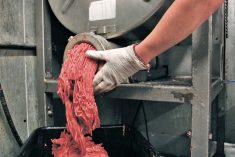Fresh and frozen ground beef treated with irradiation can now be sold in Canada, the federal health department announced Wednesday.
Health Canada has published regulations in the Canada Gazette which add fresh and frozen ground beef to the short list of irradiated foods, such as potatoes, onions, spices and flour, that are permitted for sale, effective immediately on publication.
“Permitting this technology will give the beef industry another tool to enhance food safety,” Health Canada said Wednesday in a release.
Any foods treated with irradiation must be labelled as such on its packaging, including a written description and the distinctive “Radura” symbol (shown below). Unpackaged foods must have signage displaying the same information at point of sale.
Read Also

U.S. livestock: ‘Cattle on feed’ report supports prices
Chicago cattle futures rose as the USDA’s ‘Cattle on Feed’ report showed inventories two per cent down from a year…
Irradiated foods are treated with low levels of ionizing radiation, which have been shown to reduce levels of harmful bacteria, such as E. coli, salmonella and campylobacter, prevent premature spoilage and extend foods’ shelf lives, the department said.
Irradiation of food by gamma rays, x-rays or high-energy electrons under approved conditions does not cause food to become radioactive, nor does the food come in contact with the radioactive source, the department said.
The process, Health Canada said, “is intended to complement rather than replace existing food safety practices, such as appropriate handling, storage and sanitation.”
The process will not be made mandatory, Health Canada said, and can be applied within permissible amounts “at the discretion of food producers.”
The U.S. has allowed the sale of irradiated ground beef since 1999, Health Canada noted, and 23 other countries including Brazil, South Africa, Saudi Arabia and Russia also allow irradiation of meats. The European Union overall doesn’t allow irradiation for ground beef but member nations such as the U.K., France, Belgium and the Netherlands allow it on chicken meat and poultry.
Health Canada said it reviewed an application in 1998 seeking approval for irradiation of ground beef to reduce microbial load, but the regulatory process wasn’t completed at that time, “due to the large number of questions received expressing concerns related to the safety of the food irradiation process in general.”
A new application “nearly identical to the 1998 submission” was submitted in May 2013, Health Canada said. The department’s safety and efficacy evaluation found the “available scientific data support the safety of irradiating fresh and frozen raw ground beef as described in the current submission” as well as the process’ efficacy in reducing pathogen load.
Among the differences in the 2013 application over the 1998 submission, Health Canada noted, was a request for a higher maximum operating energy level for X-ray machine sources of radiation at 7.5 million electron volts, up from five million. The higher level lines up with the level approved in the U.S.
While the maximum energy level is higher, Health Canada said, the maximum absorbed dose of ionizing radiation in the beef remains the same: 4.5 kilograys for fresh raw ground beef and seven kGy for frozen raw ground beef.
Health Canada’s Food Directorate “has not identified a safety concern with the proposed change to the maximum energy level.”
Health Canada cautioned that irradiation “cannot guarantee the absence of disease-causing microorganisms, but it greatly reduces their number… Irradiated food must still be handled, stored and cooked properly like all other foods.”
The 2013 application came from the Canadian Cattlemen’s Association, which at the time said that “combined with food safety interventions already in use, irradiation could essentially eliminate E. coli-related illness associated with ground beef… (which is) reason enough to support making this choice available to Canadians.”
The CCA said Wednesday buying irradiated ground beef “is now a choice for Canadian consumers, the same choice that has been available in the U.S. for more than a decade.”
That said, the CCA added, the availability of irradiated beef “will take time to establish and will depend on consumer demand for this type of product.”
The Canadian Meat Council, which supported the CCA’s application, said at the time the process could help “reduce human illness and suffering; decrease healthcare expenditures; improve confidence in Canada’s food safety system; benefit Canadians economically; and, finally, provide Canadian consumers with the opportunity to exercise individual choice, a freedom which (U.S.) consumers have long held.”
The CMC at the time said it would also encourage Health Canada to give “prompt consideration to science-based proposals on irradiation as an effective food safety technology for other meat products such as beef trim as well as chicken meat and poultry.”
During consultations last year on the proposed regulatory changes, Canada’s National Farmers Union came out opposed, saying larger beef packers such as Cargill and JBS, could turn to irradiation as a cost-cutting food safety measure, further undercutting smaller packers on beef pricing.
The NFU at the time said it was also concerned packers and processors might use irradiation as a crutch “to compensate for unsanitary conditions and inadequate procedures (and) instil a false confidence in the meat’s safety.”
Processors, the NFU said, could use irradiation to control “fecal contamination of carcasses that occurs when processing high volumes at high speeds without adequate inspection of production lines.” — AGCanada.com Network
















